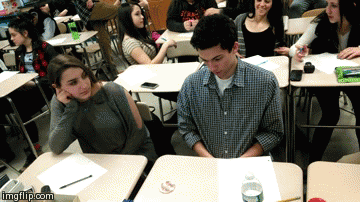Day 108: Intro to Projectile Motion and Video Analysis
College-Prep Physics: This is our first time doing video analysis and I was only able to get the computer lab for 1 class period. So I made the activity very structured. We used a pre-made video from Live Photo Physics and I gave detailed instructions on the mechanics of video analysis using Logger Pro.
You can download the instructions here: Projectile Motion Video Analysis DIRECTIONS 2014
NOTE: I can’t seem to find the video on the Live Photo Physics website, so I’ve upload it here: Ball_Toss_12.mov If anyone knows the original location of the video, please let me know.
Day 106: Why I Teach Free Fall AFTER Forces
College-Prep Physics: On whiteboards, students were asked to predict the model for the force and motion of a dropped ball soccer ball (m = 0.4 kg):
- Draw a motion diagram, a position-time graph, a velocity-time graph, and a force diagram.
- Determine the ball’s acceleration.
Then, as a class, we tested our predictions using Logger Pro and a motion detector (red graph above).
Next, I asked them to determine the acceleration for a ball with twice the mass. Most groups immediately said it would still be -9.8 m/s/s. Some referred to prior knowledge that all objects fall at the same rate. Others referred to the math they just did on their whiteboards — doubling the mass doubles both the gravitational force on the ball and its mass, so the acceleration will remain the same.
Gravitational acceleration = 9.8 m/s/s for all objects. Why? Why not? (Sometimes, always, never)
Show hammer and feather dropped on moon.
Now predict the model for the force and motion of a tossed ball rising and falling — just after leaving hand to just before catch.
- Motion diagram, position-time graph, velocity-time graph, force diagram.
- Determine the ball’s acceleration.
What’s the same as before? What’s different than before? Why?
Then, as a class, we tested our predictions using Logger Pro and a motion detector (blue graph above).
Because students had already done forces, Newton’s Laws, and dynamics, these free fall scenarios were just natural extensions.





